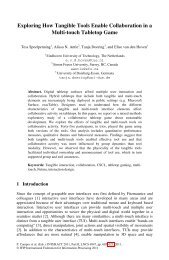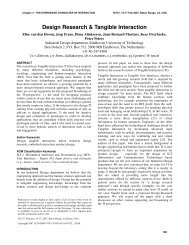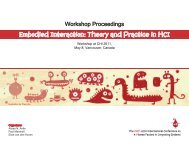Sissy - Elise van den Hoven
Sissy - Elise van den Hoven
Sissy - Elise van den Hoven
You also want an ePaper? Increase the reach of your titles
YUMPU automatically turns print PDFs into web optimized ePapers that Google loves.
interactions [12]. A specific goal of the activity was to<br />
provide participants with a bodily understanding of the<br />
findings and to ground subsequent design activities.<br />
Figure 1: Theme card (l) and associated video clip (r)<br />
Each participant was provided with a different ‘theme<br />
card’, which was an abbreviated version of the themes of<br />
interaction that had been developed from our earlier<br />
studies. Theme cards were printed on A5 sized paper and<br />
consisted of a title, a brief summary and a written<br />
description of the action on an example video clip from<br />
the field studies (Figure 1).<br />
Figure 2: Mirroring gestures of <strong>den</strong>tists in projected video<br />
Each participant read out their theme card for the rest of<br />
the group. Following this the example video clip for that<br />
theme was projected on a wall and the whole group was<br />
asked to watch the clip and try to mirror the action that<br />
they saw there (Figure 2). Because it is difficult to follow<br />
and mirror the interaction in a short clip upon first<br />
viewing, the clips were repeated several times with the<br />
group watching and mirroring each time until everyone<br />
felt that they had a feeling for the clip and the theme. At<br />
this point, we took a round to discuss our experiences and<br />
observations about the theme in the light of the video<br />
clip. If the participants felt it was necessary, the clip<br />
could be replayed with participants watching or mirroring<br />
the action again.<br />
The difficulty of mirroring<br />
A majority of the participants had participated in previous<br />
collaborative analysis activities and therefore already had<br />
some familiarity with the themes that were presented. It<br />
might be expected from this that there would not be many<br />
new insights into the themes, but this was not the case. A<br />
big surprise was how difficult it actually was to mirror the<br />
gestures in the clips. This seemed due to the fact that<br />
whereas we were attempting to perform gestures that we<br />
saw projected on a screen, the people who had been video<br />
6<br />
recorded were performing gestures situated within a<br />
context of activity. This highlighted aspects of the context<br />
that we had not previously paid a lot of attention to in<br />
terms of the role they play in structuring the actions and<br />
gestures within the <strong>den</strong>tal surgery. Specifically, we<br />
became aware of and discussed the following points:<br />
• Posture: Whereas the <strong>den</strong>tists were usually sitting in<br />
low stools, and the patients were usually lying down,<br />
the workshop participants were standing. Posture has<br />
a significant effect on how it feels to perform a<br />
gesture.<br />
• Direction of gaze: Whereas participants stood<br />
looking at the video screen while mimicking the<br />
actions they saw there, the people portrayed in the<br />
clips directed their gaze at the person they were<br />
talking to, towards the place where they were<br />
working, and so on. Gaze and gesture are intimately<br />
linked in interaction.<br />
• Instruments and artefacts: The <strong>den</strong>tist often held<br />
instruments in his hands while working and also<br />
while gesturing to the patient. For the participants,<br />
who did not have these artefacts, it was difficult to<br />
know how precisely to make their gestures.<br />
Instruments and artefacts help shape gestures.<br />
• Positioning in relation to others: When the <strong>den</strong>tist<br />
made a gesture towards another person, or passed the<br />
instruments to someone else, the location of that<br />
other person gave a direction for them to orient to.<br />
Gestures are made in relation to other people and<br />
locations.<br />
In developing these themes we had noticed several of<br />
these themes and indeed most of the theme cards that<br />
were provided to participants made explicit mention of<br />
them. Yet they passed with little comment when first<br />
introduced. It seems that we had not really felt what they<br />
meant until we tried to bring our own bodies into similar<br />
kinds of gestural relationships. A pertinent factor is that<br />
our prior engagement with the video data had been more<br />
traditional analytic modes of viewing and video while<br />
making written notes and then discussing observations<br />
with colleagues. Though analytic activities also require<br />
bodily engagement, it seems rele<strong>van</strong>t that the video<br />
mirror activity brought our abilities for gestural mirroring<br />
and movement to the fore. We want to emphasize here<br />
that it was not the verisimilitude of the videos themselves<br />
that prompted our discussion of these themes, but that the<br />
activity allowed for a bodily exploration and experience<br />
of gesture and of the difficulties associated with that.<br />
Tracing Movements<br />
Later in the same project, we again made use of projected<br />
video as a way of getting a feel for the movements in a<br />
<strong>den</strong>tal examination. At this time, we were working<br />
through a more conventional interaction analysis of one<br />
episode of work in a <strong>den</strong>tal examination based on written<br />
transcripts of activity. The video that this analysis was<br />
based on had been taken from a tripod-mounted camera<br />
positioned at the foot of the <strong>den</strong>tal chair, which meant<br />
that there was a stable framing of the image from the start



![Download 1.8 MB [pdf] - Elise van den Hoven](https://img.yumpu.com/18078175/1/190x245/download-18-mb-pdf-elise-van-den-hoven.jpg?quality=85)

![Download 0.2 MB [pdf] - Elise van den Hoven](https://img.yumpu.com/18078145/1/182x260/download-02-mb-pdf-elise-van-den-hoven.jpg?quality=85)
![Download 0.1 MB [pdf] - Elise van den Hoven](https://img.yumpu.com/18078125/1/190x146/download-01-mb-pdf-elise-van-den-hoven.jpg?quality=85)
![Download 1.9 MB [pdf] - Elise van den Hoven](https://img.yumpu.com/18078041/1/182x260/download-19-mb-pdf-elise-van-den-hoven.jpg?quality=85)

